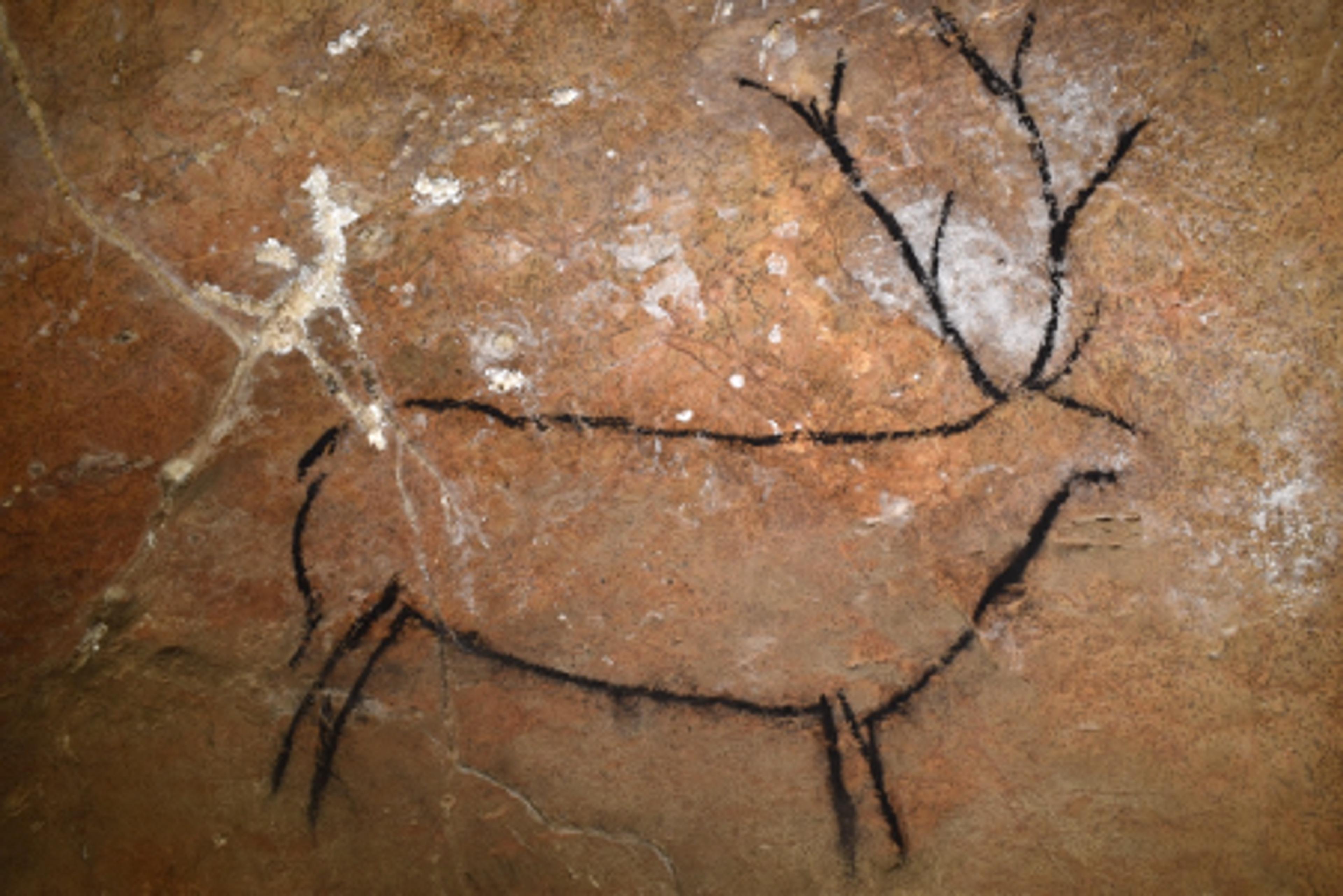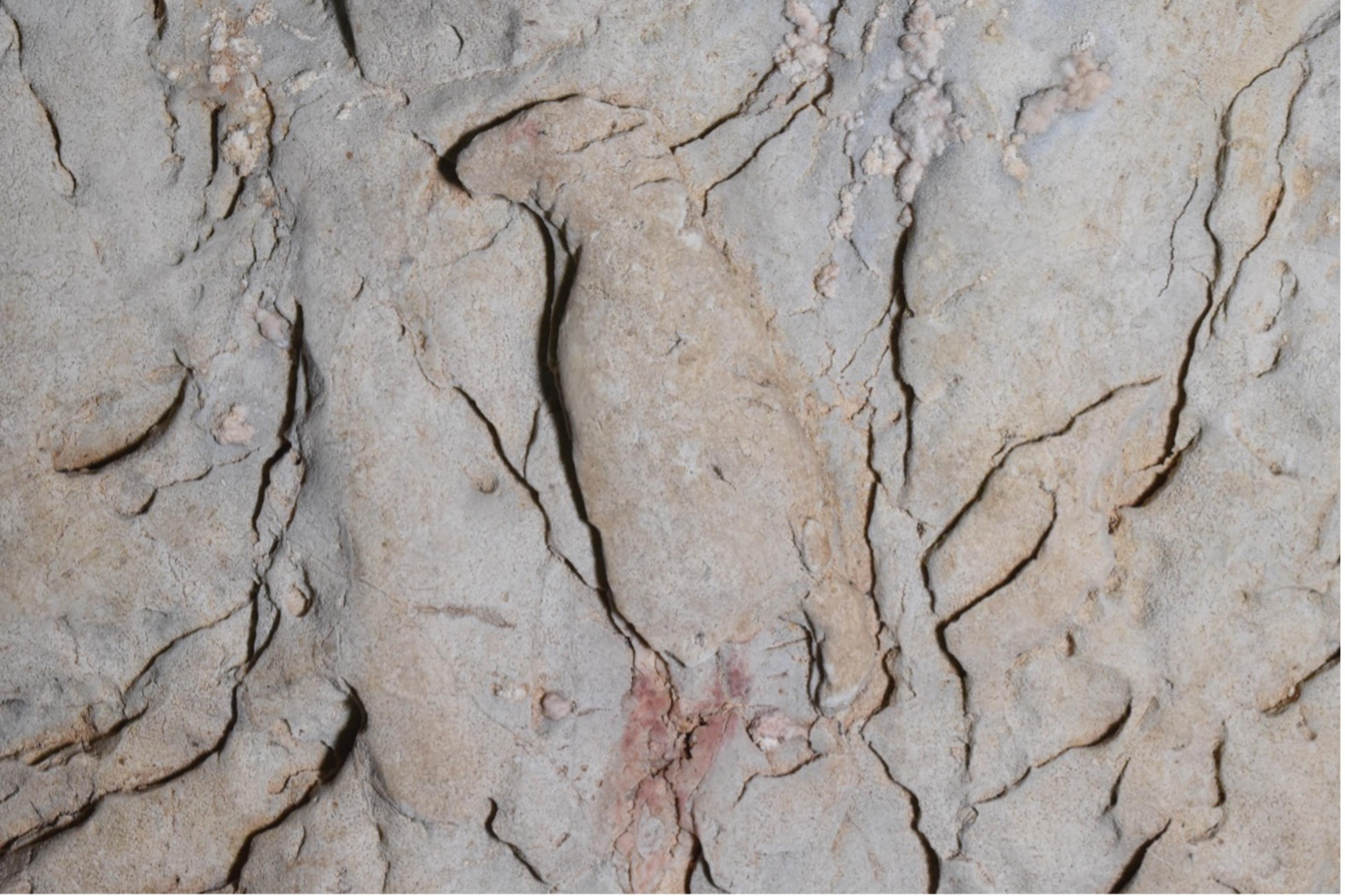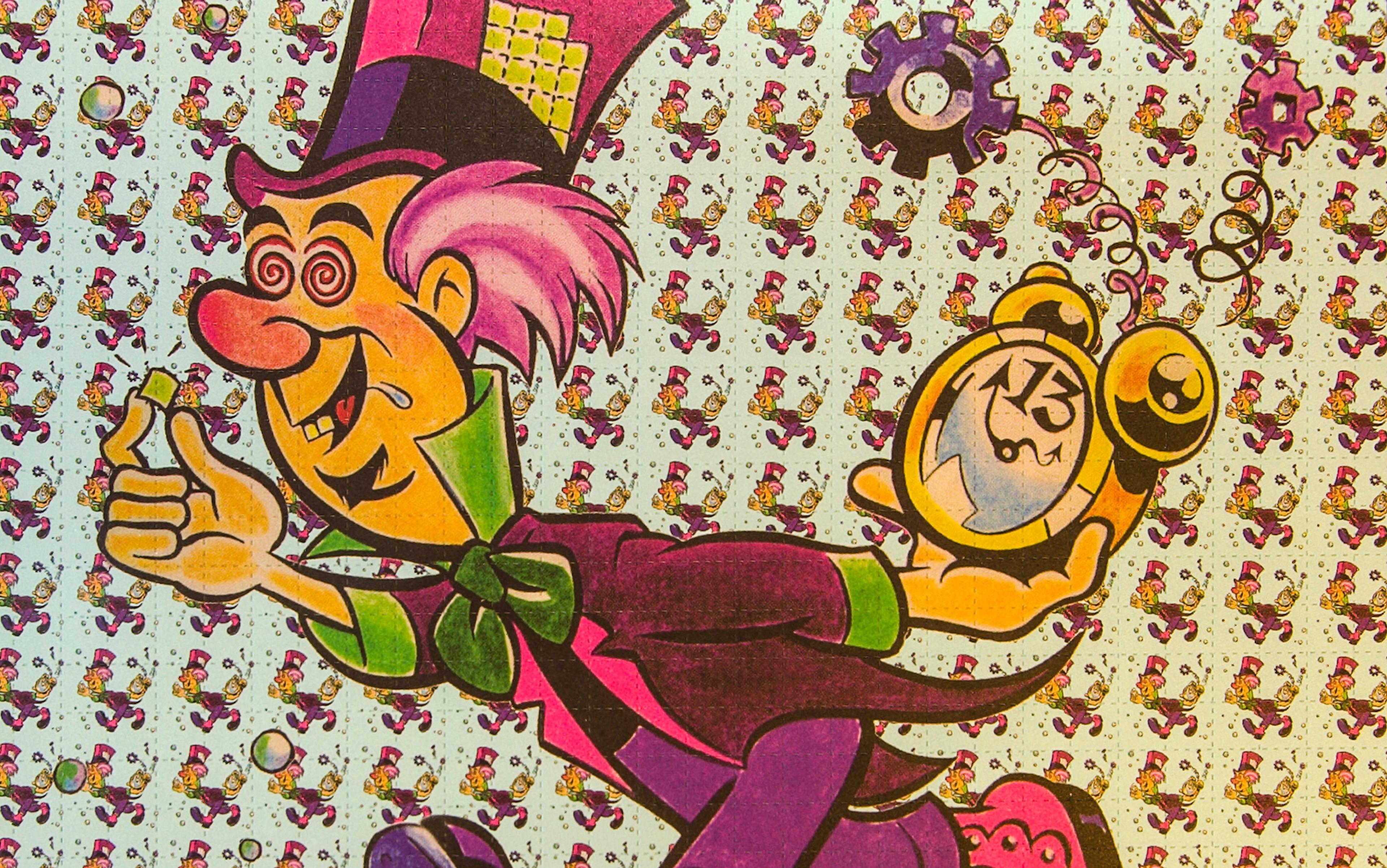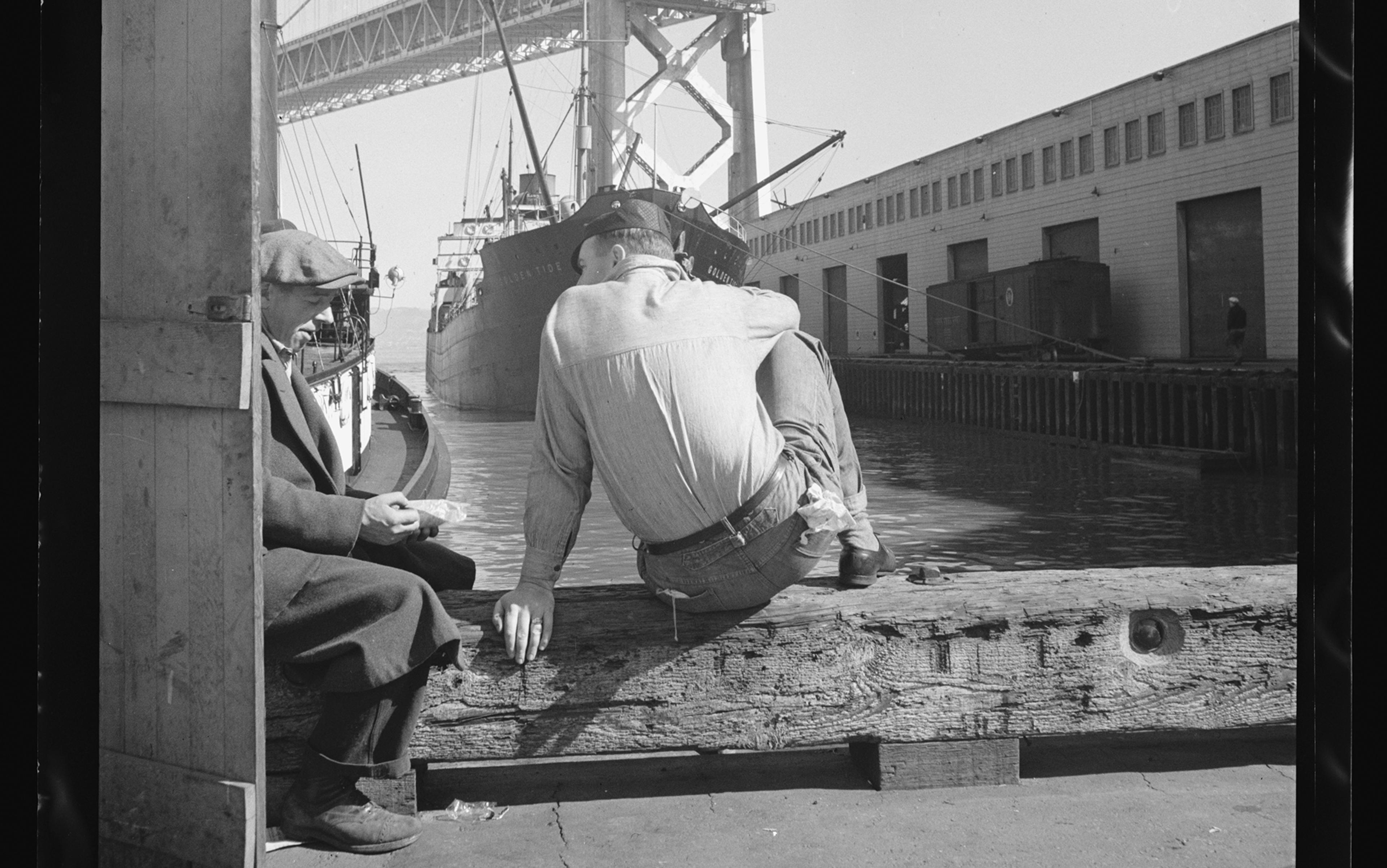Charcoal drawings of stags, elegantly rendered in fluid lines, emerge under my torchlight as we squeeze through a tiny hidden entrance to a small chamber deep within Las Chimeneas cave in northern Spain. The chamber has space for just a couple of people, and certainly not standing, so we crouch on the cave floor and stare in awe at the depictions. Despite their remarkable freshness, they were drawn nearly 18,000 years ago. We sit in silence for a moment, soaking in the deep history of the space and realising that our ancient ancestors must have sat in the same cramped position as us. ‘Why do you think they drew these stags here?’ Eduardo Palacio-Pérez, the conservator of the cave, asks me. ‘I really don’t think we’ll ever know for sure,’ I reply.

What we do know is that during the Upper Palaeolithic (c45,000-15,000 years ago), our distant ancestors ventured deep underground to make these images. In these unfamiliar environments, they produced a rich display – from unusual abstract forms to highly detailed renderings of animals – under the dim glow of firelight cast by their lamps. Naturalistic animal outlines, rows of finger-dotted marks and splatter marks preserving the shadows of ancient hands remain frozen in time within the caves, representing tens of thousands of years of people returning to the darkness to engage in art-making.
This curious, yet deeply creative, behaviour captures the imagination. Yet as Jean Clottes – a prominent Palaeolithic art researcher – succinctly put it, the key unanswered question for us all is: ‘Why did they draw in those caves?’
Certainly, since the earliest discovery of cave art in 1868 at Altamira in Spain, thousands of academic researchers have used an arsenal of different approaches – from high-resolution 3D scanning to analogies with contemporary hunter-gatherer societies – to try to unlock the intentions of Ice Age artists. There has been no shortage of hypotheses, some more plausible than others. Since the fragmentary archaeological record cannot provide answers alone, these theories draw on ethnographic and psychological research, and suggestions have varied from the mythical and magical, the symbolic and linguistic, to the mundane.
One suggestion is that Ice Age artists were high-status shamans who performed mysterious rites in the dark. These spiritual individuals are thought to have induced trance-like states deep in the caves, either through rhythmic drumming or mind-altering drugs. Altered states of consciousness may have facilitated communicating with ancestors, experiencing otherworldly psychedelic imagery, or coaxing animals out from a spirit world beyond the rocky surfaces of deep cave environments. The shaman hypothesis draws on ethnographic accounts and has come under significant criticism both for inappropriately drawing parallels between peoples today and those who lived in the deep past, and for subsuming a huge breadth of cultural behaviours under one label: ‘shamanism’.
Flickering firelight, echoing acoustics and tactile interactions form visceral experiences for each artist
A different hypothesis is that abstract marks and ‘signs’ on cave walls were a proto-writing system or part of a widespread means of communication. These communication systems are posited to have had a plethora of different contexts of use, from marking the changing seasons to denoting group identities. On this view, caves were rich resources for understanding the surrounding environment, for recording which animals were where, when they would reproduce, and for developing awareness of the presence of other local populations of people in the area. As supporting evidence, some researchers have singled out the ethologically accurate details: the colouring of the horses depicted reflects the genetic diversity of Ice Age horses; the shaggy winter coats of animals are shown accurately; and even specific animal behaviour can be identified. Yet, somewhat paradoxically, these interpretations assume a kind of stasis to the cave art. Temporal dimensions of the art are collapsed into one system that is assumed to have persisted across thousands of years of changing climates and shifting population dynamics.
These kinds of evocative interpretations of cave art, situating it within rich cultural milieus, contrast with the view that Palaeolithic art was merely ‘art for art’s sake’. Here, the enigmatic images on cave walls are assumed to have been produced by bored hunters who spent time honing their artistic abilities to create aesthetically pleasing depictions. Abstract signs are explained neurologically as pleasing patterns: intersecting lines, for example, resonate within the visual system to stimulate aesthetic pleasure. This view casts Ice Age art-making as a practice that emerged from our ancestors’ neurology – the tendency for some shapes and patterns to be ‘pleasing’ – and held no deeper meaning to the societies that created the depictions.
More nuanced approaches to Ice Age art that, unlike the above hypotheses discussed so far, do not seek one explanation for the artist’s motivations have revealed the multisensory experiences that would have been the context in which Ice Age art was created. Flickering firelight, echoing acoustics, multigenerational engagements with artistic behaviours and tactile interactions with the rough limestone walls and smooth stalagmites coalesce to form unique, visceral experiences for each artist at a specific time in a specific place. While the actual motivations of our ancestors are locked in time, these more nuanced perspectives situate us in the deeply human experiences of the past. We can begin to understand why our ancestors may have been attracted to particular cave spaces and to the sorts of sensory experiences stimulated in these environments, particularly visual experiences.
Close your eyes. Take a deep breath. You’re standing in a cave, tens of thousands of years ago. The damp, earthen smell mixes with the warm smoke from your firelit torch and saturates your nostrils. The muted silence is broken only by the subtle crackles of the fire and distant drips of water that echo around the space. You’re alone, but feel the presence of those who have stood in this place before you.
Open your eyes. The darkness is encompassing, and the warm glow of firelight desperately tries to illuminate the vast space around you. It is almost impossible to distinguish anything. As you gingerly move forward, feeling your way through the dark, the flickering light cast from your torch partially illuminates a peculiar formation on the cave wall.
Our vision can rarely be trusted. Far from faithfully reproducing an accurate image of the world around us, our visual system selectively focuses on important information in our environment. As you read the words in this article, your eyes are rapidly flicking between different letters, as your visual system is making educated guesses about what each of the words says. This means that lteters can appaer out of oredr, but you can still read them with relative ease. Your surroundings are not the focus of your attention right now, and your visual system is making a fundamental assumption that these surroundings will remain mostly static. In your peripheral vision, a significant amount of visual information can change without your knowledge; colours can shift, and objects themselves can completely change their form. Only movement appears to be readily detected by peripheral vision, presumably so as not to render us completely inert when danger approaches and our attention is focused elsewhere. Visual illusions play on exactly these processes, demonstrating how unfaithful our vision truly is in relaying an unbiased representation of our surroundings.
All of us have perceived twisting tree trunks in dim light as unusual creatures emerging from the darkness
The reason behind this selectivity in our visual attention is not some flaw in human evolution, but the opposite. By focusing attention and making educated guesses about missing information, we can rapidly process visual information and sharpen our gaze on only the most salient pieces of information in our visual sphere. This is intrinsically informed by our lived experience of the world. As elegantly framed by the neuropsychologist Chris Frith in his book Making Up the Mind (2007), what we perceive is ‘not the crude and ambiguous cues that impinge from the outside world onto [our] eyes and [our] ears and [our] fingers. [We] perceive something much richer – a picture that combines all these crude signals with a wealth of past experience.’
Our visual system is thus trained to become expert in certain kinds of visual information that are understood to be important to us. This visual expertise is defined as the ability to holistically process certain kinds of information, so that we identify the individual as rapidly as the group classification; for example, we can identify the identity of an individual person (‘Joolz’) as quickly as we identify that it is ‘a person’ standing in front of us. While it is often culturally determined what kinds of visual information we develop expertise in, we can also consciously develop this ability. Expert birdwatchers, for example, rapidly identify the specific species of bird as quickly as they identify that it is, indeed, a bird that they are looking at. This kind of expertise shapes how the visual system both focuses its attention and fills in the blanks when information is missing.
Pareidolia – a visual phenomenon of seeing meaningful forms in random patterns – seems to be a product of this way in which our visual system selectively focuses on certain visual information and makes assumptions when ‘completing’ the image. Pareidolia is a universal experience; all of us have looked at clouds and recognised faces and animals, or perceived gnarled, twisting tree trunks in dim light as unusual creatures emerging from the darkness. While we might think of these visual images as a mistake – we know there isn’t a large face looming down at us from the clouds – it seems to have emerged as an evolutionary advantage. By assuming that a fragmentary outline is, in fact, a predator hiding in foliage, we can react quickly and avoid a grisly death, even if said predator turns out to be an illusion caused by merely branches and leaves.
This evolutionary advantage is stimulated even further in compromised visual conditions, such as low light. Our visual system kicks into overdrive and uses what we know about the world, formed by our daily lived experience, to fill in missing information. For those of us living in highly populated, socially orientated societies, this means our experience of pareidolia often manifests as faces. We have been culturally trained to focus our visual attention primarily on facial intricacies, rapidly processing the similarities and differences in appearances, or even subtle cues that may indicate an emotional state. This lived experience of an oversaturation of facial information shapes our response to ambiguous visual information: we see faces everywhere.
If we imagine, however, that we lived in small groups within a sparsely populated landscape where our survival depended on the ability to identify, track and hunt animals, we might reasonably expect that our visual system would become attuned to certain animal forms instead. We would be visually trained to identify the partial outlines of animals hiding behind foliage or the distant, vague outlines of creatures far away in the landscape. We would even have an intimate knowledge of their behaviours, how they move through the landscape, the subtle cues of twitching ears or raised heads that indicate they might be alerted to our presence. Our Ice Age ancestors may have therefore experienced animal pareidolia to the same degree that we experience face pareidolia. Where we anthropomorphise and perceive faces, they would have zoomorphised and perceived animals.
‘Is that…?’ You begin to doubt your own eyes. A shadow flickers, drawing your attention to the movement. Cracks, fissures and undulating shapes of the cave wall start to blur in the darkness to form something familiar to your eyes. Under the firelight, it is difficult to distinguish it immediately. As it flickers in and out of view, you start to see horns formed by cracks, the subtle curvature of the wall as muscular features. A bison takes shape and emerges from the darkness.
How do these visual, sensory experiences relate to Ice Age cave art-making? This was the question that burned in my mind during my research. For some time, it has been known that the artists who created animal imagery in caves often utilised natural features, integrating cracks to represent the backs of animals or the varied topography to add a sense of three-dimensionality to their images. The first known cave-art discovery – the bison at Altamira – represents the use of undulating convexities and concavities to give dimension and form to the depictions of bison, which silently lay with their legs curled underneath their bodies on the low cave ceiling. So-called ‘masks’ from this cave and others in the region are further examples of using the natural forms of caves to produce depictions; these often take a formation that appears to be a zoomorphic head and add subtle details of the eyes and nostrils to complete the form. Similarly, subtle animal depictions emerge from natural shapes embedded in cave walls that are enhanced with a few details added by ochre-covered fingers. Thus, far from perceiving the cave wall as a blank canvas, it seems these innovative artists actively used cave features to shape and enrich their depictions.

These striking examples clearly indicate the role of pareidolia in the production of at least some cave-art depictions. The most robust theoretical discussions of the potential role of pareidolia in Ice Age art have been presented by Derek Hodgson. He suggests that the dark conditions of caves would have heightened visual responses, triggering pareidolia or more visceral visual responses such as hyper-images (think of that split second when you perceive a person standing in your room at night, before you realise it’s just your coat hanging on the back of the door). Although compelling, the inherent challenge with these interpretations is that they do not provide empirical evidence – beyond informal observations of the archaeological record – to scientifically test whether pareidolia was indeed informing the making of Ice Age art.
Some even saw the same animal in the same cracks and undulations of the cave wall as depicted by Ice Age people
I wanted to see if there was a way to empirically test whether cave environments do trigger certain visual psychological phenomena. How can we create immersive cave environments that stimulate ecologically valid responses, yet allow us to experimentally control conditions? Since bringing flaming torches into precious Ice Age cave-art sites was absolutely out of the question, virtual reality (VR) seemed to be the natural answer. By recreating the conditions in which Ice Age artists would have viewed cave walls, we could do something that has not been possible previously: see whether people today are visually drawn to the same areas of the cave walls used by ancient artists.
In a recent study published in Nature: Scientific Reports, we did exactly this. We built VR cave environments that integrated 3D models of the real cave walls from sites in northern Spain, and modified the 3D models to remove any traces of the Palaeolithic art. We modified the lighting conditions to replicate the darkness of caves, and gave participants a virtual torch that had the same properties as lighting technologies available to Ice Age artists, to illuminate their surroundings. We asked participants to view the cave walls, and gradually gave more focused questions about whether they would draw anything on the wall, where their drawings would be, and why. Using eye-tracking technology, we were also able to see where the participants were unconsciously focusing their visual attention during the experiment. We hypothesised that both the participants’ experiential responses and their unconscious eye movements would correspond to the same areas of the cave wall that Palaeolithic artists used.
‘What do you see?’ a distant voice echoes out. ‘This crack and the undulating shape of the wall… it looks like a bison, the shape of the cave wall almost completes the head and back of it,’ you reply, and stretch out your hand in the virtual space to trace the shape. Later you find out that this corresponded to the same area a Palaeolithic artist also depicted a bison, using the same natural features that drew your own visual attention.
Our results supported our hypothesis: it seems pareidolia may have played a role in the making of some of the cave-art images. Participants not only experienced pareidolia in response to the cave walls they viewed, but also had this experience in response to the same features that Ice Age artists utilised for their drawings. Some participants had potent responses, where they literally perceived certain animals as already existing on the cave wall in front of them. Others even saw the same animal in the same cracks and undulations of the cave wall as was depicted by Ice Age people – ie, they perceived a bison in the same place as a bison was drawn. Not all of the art had such a convincing relationship with pareidolia, however. In some cases, it seems that pareidolia may not have motivated the making of the art. This is supported by another study we conducted, where we suggest the degree to which pareidolia-informed cave art varied: it was part of a ‘conversation’ that occurred between the artist and the cave wall.
The deep meaning of seeing these animal forms in cave walls and ‘releasing’ them would have undoubtedly varied cross-culturally and temporally. In one instance, it may have been part of powerful rites in the dark, where elusive figures integrated this act within other cultural or cosmological rituals, witnessed by ancestral spirits and the community alike. In another, it may have been a more intimate, discreet engagement between just one individual and the cave wall; the soft whispers of fingers brushing pigment on stone to depict an animal of deep importance to them. The perspective of time may prevent us from ever distinguishing between the two, but the foundations of these actions may have been the phenomenon of pareidolia.
This has significant implications for understanding art-making – its emergence and experience – and not just within the Ice Age. The ability to draw something that exists in four dimensions (with time, expressed as the movement of an animal, representing the fourth dimension) is non-trivial; it requires the complex processing and abstraction of visual information. Pareidolia may have been the mechanism through which figurative representation emerged, scaffolding the ability to draw things two-dimensionally. By seeing hidden forms in cave walls, we learnt how forms can be represented. It may have started as adding subtle details to elucidate the form; a small smear of ochre here or there, and suddenly the animal emerges. As time passed, the potential of using pigment to produce animal representations developed, and gradually more detailed forms were produced on a greater variety of material substrates. It became engrained more and more within every culture and society on Earth, until one day a cave artist drew an animal on a smooth rock surface.






